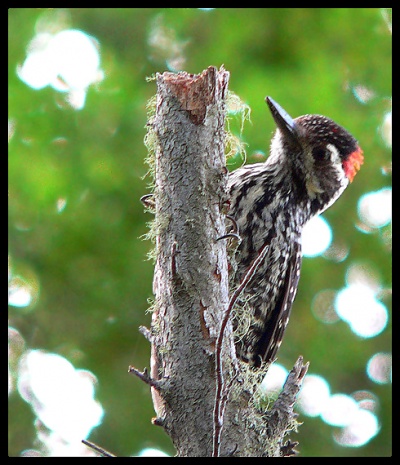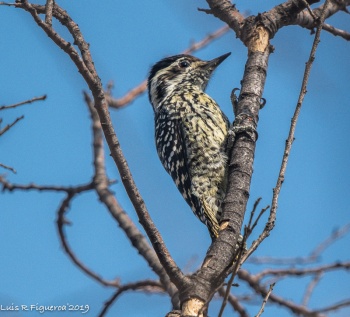(Picture showing underwings. C/right. References updated) |
(taxon, refs) |
||
| (3 intermediate revisions by one other user not shown) | |||
| Line 1: | Line 1: | ||
| − | [[Image:Stripedwoodpecker.jpg|thumb| | + | [[Image:Stripedwoodpecker.jpg|thumb|400px|right|Photo © by {{user|Rodrigo+Reyes|Rodrigo Reyes}}<br />Photo taken: Patagonia, [[Chile]], December 2006]] |
;[[:Category:Veniliornis|Veniliornis]] lignarius | ;[[:Category:Veniliornis|Veniliornis]] lignarius | ||
| − | ''Picoides lignarius'' | + | ''Picoides lignarius''<br /> |
| + | ''Dryobates lignarius'' | ||
==Identification== | ==Identification== | ||
| − | [[Image: | + | [[Image:Carpinterito-5137.jpg|thumb|350px|right|Female<br />Photo © by {{user|Luis+R|Luis R}}<br />Mahuida Park. Santiago de [[Chile]], 19 April 2019]] |
15–16 cm (6-6¼ in)<br /> | 15–16 cm (6-6¼ in)<br /> | ||
'''Male''' | '''Male''' | ||
| Line 17: | Line 18: | ||
[[South America]]: found in the arid highlands of [[Bolivia]] to southern [[Chile]] and southern [[Argentina]] | [[South America]]: found in the arid highlands of [[Bolivia]] to southern [[Chile]] and southern [[Argentina]] | ||
==Taxonomy== | ==Taxonomy== | ||
| − | + | Recent results will place this species in genus ''[[: Category:Veniliornis|Veniliornis]]'' or in genus ''[[: Category:Dryobates|Dryobates]]'' instead of the traditional placement in ''[[:Category:Picoides|Picoides]]''. | |
| − | |||
| − | Recent results will place this species in genus ''[[: Category:Veniliornis|Veniliornis]]'' instead of the traditional placement in ''[[:Category:Picoides|Picoides]]''. | ||
| + | ====Subspecies==== | ||
| + | Clements recognizes these subspecies[[#References|[1]]]: | ||
| + | *''V. l. puncticeps'': dry inter-Andean valleys from south-central [[Bolivia]] to northern [[Argentina]] (northern Salta) | ||
| + | *''V. l. lignarius'': arid highlands from northern [[Argentina]] (central Salta) to southern [[Chile]] and southern Argentina | ||
| + | These two subspecies are rumored to differ in voice! | ||
==Habitat== | ==Habitat== | ||
| − | |||
Humid open forests, woodland and dense scrub. | Humid open forests, woodland and dense scrub. | ||
==Behaviour== | ==Behaviour== | ||
====Breeding==== | ====Breeding==== | ||
| + | [[Image:Veniliornis lignarius couple.jpg|thumb|300px|right|Male above, female below<br />Photo © by {{user|Luis+R|Luis R}}<br />Rungue, Santiago Metropolitan Region, [[Chile]], October 2018]] | ||
The nest is a tree hole, drilled out by their strong bill. The clutch consists of 3-4 white eggs. | The nest is a tree hole, drilled out by their strong bill. The clutch consists of 3-4 white eggs. | ||
====Diet==== | ====Diet==== | ||
| − | Their diet is little recorded, but appears to | + | Their diet is little recorded, but appears to consist almost entirely of insects and their larva. |
==References== | ==References== | ||
| − | #{{Ref- | + | #{{Ref-Clements6thOct24}}#{{Ref-GillDonskerRasmussen24V14.2}}#[http://bio.wayne.edu/profhtml/moore/PUBLICATIONS/MooreEtal2006Veniliornis.pdf Paper] describing DNA based phylogeny of among others, this species |
#[http://www.museum.lsu.edu/~remsen/SACCprop262.html SACC] proposal to move this species | #[http://www.museum.lsu.edu/~remsen/SACCprop262.html SACC] proposal to move this species | ||
#Handbook of the Birds of the World Alive (retrieved February 2016) | #Handbook of the Birds of the World Alive (retrieved February 2016) | ||
| Line 37: | Line 41: | ||
{{ref}} | {{ref}} | ||
==External Links== | ==External Links== | ||
| − | {{GSearch|Woodpecker | + | {{GSearch|"Veniliornis lignarius" {{!}} "Picoides lignarius" {{!}} "Dryobates lignarius" {{!}} "Striped Woodpecker"}} |
| + | {{GS-checked}}1 | ||
| + | <br /> | ||
| + | <br /> | ||
[[Category:Birds]][[Category:Picoides]] | [[Category:Birds]][[Category:Picoides]] | ||
Latest revision as of 00:18, 15 February 2025
- Veniliornis lignarius
Picoides lignarius
Dryobates lignarius
Identification
15–16 cm (6-6¼ in)
Male
- Black forehead and crown
- Some streaking on crown
- Red (or reddish-orange) nape; lacking in the female
- Whitish face with black stripe through the eye
- Black and white bars on upperparts
- White spots on wings and wing coverts
- White under wing coverts
- Yellowish underparts
Distribution
South America: found in the arid highlands of Bolivia to southern Chile and southern Argentina
Taxonomy
Recent results will place this species in genus Veniliornis or in genus Dryobates instead of the traditional placement in Picoides.
Subspecies
Clements recognizes these subspecies[1]:
- V. l. puncticeps: dry inter-Andean valleys from south-central Bolivia to northern Argentina (northern Salta)
- V. l. lignarius: arid highlands from northern Argentina (central Salta) to southern Chile and southern Argentina
These two subspecies are rumored to differ in voice!
Habitat
Humid open forests, woodland and dense scrub.
Behaviour
Breeding
The nest is a tree hole, drilled out by their strong bill. The clutch consists of 3-4 white eggs.
Diet
Their diet is little recorded, but appears to consist almost entirely of insects and their larva.
References
- Clements, J. F., P. C. Rasmussen, T. S. Schulenberg, M. J. Iliff, T. A. Fredericks, J. A. Gerbracht, D. Lepage, A. Spencer, S. M. Billerman, B. L. Sullivan, M. Smith, and C. L. Wood. 2024. The eBird/Clements checklist of Birds of the World: v2024. Downloaded from https://www.birds.cornell.edu/clementschecklist/download/
- Gill, F, D Donsker, and P Rasmussen (Eds). 2024. IOC World Bird List (v 14.2). Doi 10.14344/IOC.ML.14.2. http://www.worldbirdnames.org/
- Paper describing DNA based phylogeny of among others, this species
- SACC proposal to move this species
- Handbook of the Birds of the World Alive (retrieved February 2016)
- Arthur Grosset
Recommended Citation
- BirdForum Opus contributors. (2025) Striped Woodpecker. In: BirdForum, the forum for wild birds and birding. Retrieved 9 May 2025 from https://www.birdforum.net/opus/Striped_Woodpecker
External Links
GSearch checked for 2020 platform.1






